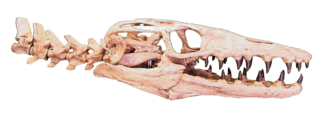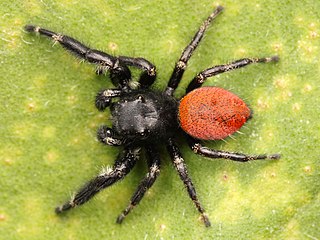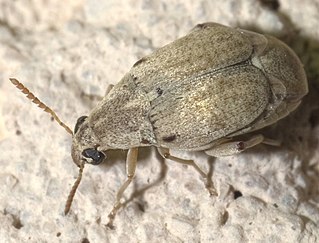
The freshwater crocodile, also known commonly as the Australian freshwater crocodile, Johnstone's crocodile, and the freshie, is a species of crocodile native to the northern regions of Australia. Unlike its much larger Australian relative, the saltwater crocodile, the freshwater crocodile is not known as a man-eater, although it bites in self-defence, and brief, nonfatal attacks have occurred, apparently the result of mistaken identity.

Selmasaurus is an extinct genus of marine lizard belonging to the mosasaur family. It is classified as part of the Plioplatecarpinae subfamily alongside genera like Angolasaurus and Platecarpus. Two species are known, S. russelli and S. johnsoni; both are exclusively known from Santonian deposits in the United States.

Phidippus johnsoni, the red-backed jumping spider or Johnson jumping spider, is one of the largest and most commonly encountered jumping spiders of western North America. It is not to be confused with the unrelated and highly venomous redback spider.

The royal sunangel is an endangered species of hummingbird in the "coquettes", tribe Lesbiini of subfamily Lesbiinae. It is found in Ecuador and Peru.
The central pebble-mound mouse is a species of rodent in the family Muridae, native to Australia. The Kimberley mouse was, until recently, considered distinct from P. johnsoni, but they are now known to be conspecific. It is one of the pebble-mound mice.
The white-spotted moray is a moray eel found in the western Indian Ocean. It was first named by Smith in 1962.
Glishades is a genus of hadrosauroid dinosaur that lived in the Late Cretaceous in North America. It is based on AMNH 27414, two partial premaxillae discovered in the Upper Cretaceous rocks of the upper Two Medicine Formation in Montana, dated to about 74.5 million years ago. Cladistic analysis conducted by Prieto-Márquez suggests that Glishades is a non-hadrosaurid hadrosauroid, probably a sister taxon to Bactrosaurus johnsoni. The type species is Glishades ericksoni.

Acanthemblemaria johnsoni, the white-cheeked blenny, is a species of chaenopsid blenny found in coral reefs around Tobago, in the western central Atlantic ocean. The specific name honours the ichthyologist G. David Johnson Curator of the Division of Fishes at the Smithsonian Institution.
Leptophlebia johnsoni, or Johnson's pronggill mayfly, is a species of pronggilled mayfly in the family Leptophlebiidae. It is found in North America.
Leucophora johnsoni is a species of root-maggot flies in the family Anthomyiidae.

Algarobius is a genus of pea and bean weevils in the beetle family Chrysomelidae. There are about six described species in Algarobius.
Apsectrotanypus johnsoni is a species of midge in the family Chironomidae.

Clusiodes johnsoni is a species of fly in the family Clusiidae.
Melecta separata is a species of hymenopteran in the family Apidae. It is found in North America.
Scaphinotus johnsoni is a species of ground beetle in the family Carabidae. It is found in North America.
Pterodontia johnsoni is a species of small-headed flies.
Paleoplatyura is a genus of predatory fungus gnats in the family Keroplatidae. There are about seven described species in Paleoplatyura. Fossil species are known from the mid-Cretaceous Burmese amber of Myanmar, dating to around 100 million years ago.
Grossoseta is a genus of flat-footed flies. There are at least two described species in Grossoseta.
Clubiona johnsoni is a species of sac spider in the family Clubionidae. It is found in the United States and Canada.

Pachycheles is a genus of porcelain crabs in the family Porcellanidae. There are more than 40 described species in Pachycheles.








